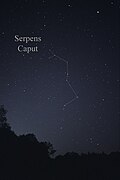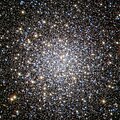Serpens
Serpens is a constellation in the northern sky.
 Click for larger image | |
| List of stars in Serpens | |
| Abbreviation: | Ser |
| Genitive: | Serpentis |
| Symbology: | |
| Right ascension: | Serpens Caput: 15h 10.4m to 16h 22.5m Serpens Cauda: 17h 16.9m to 18h 58.3m h |
| Declination: | Serpens Caput: 25.66° to -03.72° Serpens Cauda: 06.42° to -16.14°° |
| Area: | Serpens Caput: 428 sq. deg. Serpens Cauda: 208 sq. deg. Total: 637 sq. deg. (23rd) |
| Main stars: | 11 |
| Bayer/Flamsteed stars: | 57 |
| Stars known to have planets: | 15 |
| Bright stars: | 1 |
| Nearby stars: | 2 |
| Brightest star: | α Ser (Unukalhai) (2.63m) |
| Nearest star: | GJ 1224 ( ly) |
| Messier objects: | 2 |
| Meteor showers: | |
| Bordering constellations: | Serpens Caput: Corona Borealis Boötes Virgo Libra Ophiuchus Hercules Serpens Cauda: Aquila Ophiuchus Sagittarius Scutum |
| Visible at latitudes between +80° and −80° Best visible at 21:00 (9 p.m.) during the month of July | |
| Wikimedia Commons has media related to Lua error in Module:Commons_link at line 62: attempt to index field 'wikibase' (a nil value).. |
Serpens Media
Serpens held by Ophiuchus, as depicted in Urania's Mirror, a set of constellation cards published in London c. 1825. Above the tail of the serpent is the now-obsolete constellation Taurus Poniatovii while below it is Scutum
Messier 5, a globular cluster that can be seen with the naked eye under good conditions
Hoag's Object, a galaxy in Serpens and a member of the very rare class known as ring galaxies.
A composite image of 3C 321, a merging active galaxy pair
The Pillars of Creation, a well-known star-forming region in the Eagle Nebula made famous by this Hubble photograph
Westerhout 40, one of the nearest sites of massive star formation







